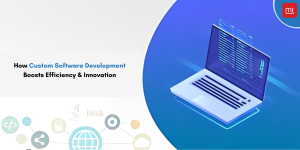How Open Source is Driving Innovation in Enterprise Software

Open source software has come a long way from being a community-driven passion project. Today, it’s playing a critical role in enterprise software development. Whether you’re running a tech startup or managing IT in a large organisation, you’ve likely encountered open source tools shaping your operations.
Enterprises are no longer considering open source a second-class citizen, with many taking it up as a product choice for developing scalable, flexible, and secure software systems. But why is this? And what does this mean for the future of enterprise software?
We’ll discuss this in detail with actionable insights, examples, and easy-to-understand descriptions.
What is Open Source Software?
Open source software is code that anyone can publicly access, inspect, modify, and share. It’s about more than free access – it embodies community, transparency, and shared responsibility.
While proprietary programs lock the code and hide it behind licenses, open source is open. There are developers all over the globe working to improve and enhance it. Think about projects like Linux, Kubernetes, or PostgreSQL – all pervasive in enterprise environments.
This community-first approach results in faster updates, quicker problem-solving, and access to innovation from every corner of the globe.
The Role of Open Source in Enterprise Software Development
Open source is well beyond tooling interoperability. It is an integral part of many enterprise solutions.
Consider these:
- Infrastructure: For example, what Docker and Kubernetes represent to cloud-native architectures is staggering.
- Databases: Companies will often rely on open-source databases (MongoDB – NoSQL or MySQL – SQL, respectively) because of their flexibility and affordability.
- Security & Monitoring: Open source solutions like Prometheus, Grafana, and things like OSSEC provide visibility and threat detection without licensing challenges.
Enterprise teams are using open source across multiple layers, including backends, frontends, DevOps, and AI/ML (Machine Learning) pipelines. It is not about substituting all a company’s proprietary tools with open source, but applying open source when it makes the most strategic sense to do so.
Enterprises are also building hybrid stacks by mixing proprietary systems with open source tools to remain agile to changing needs and to maintain control of their technological environment.
Key Ways Open Source Drives Innovation
Open source is not simply a journey to saving money. It’s also a catalyst for meaningful innovation in more than a few ways:
1. Faster Development Cycles
Because large communities often develop and maintain open source projects, patches and updates will happen quickly. That means enterprise teams can iterate more quickly, without waiting for vendor roadmaps or locked-in upgrade cycles.
2. Flexibility and Customization
The flexibility given by open source software is a big benefit compared to commercial products. At the end of the day, open-source software allows you to change the code to meet the needs of your business. This is key in an environment where off-the-shelf products simply don’t account for your internal processes.
3. Lower Total Cost of Ownership
Licensing costs can be significant for large enterprises. Open source helps reduce those expenses without sacrificing quality. Over time, this allows businesses to reallocate budgets to innovation rather than maintenance.
4. Stronger Security Through Transparency
Open codebases open themselves to security evaluations independent of the software or tool you use to review them, and bugs and vulnerabilities are often identified and remediated faster. Open source isn’t beyond risk, but the transparency often leads to faster community response and remediation.
5. Collaboration and Knowledge Sharing
Open source thrives on collective effort. Enterprises using open tools benefit from shared documentation, forums, and problem-solving by peers in the same ecosystem.
Case Studies: Enterprises Succeeding with Open Source
Take a look at how some higher-profile companies are using open source to improve their products and remain competitive:
Netflix
When it comes to open source, Netflix is doing it at an infrastructure level. In fact, Netflix engineers contribute back to the open source community in the form of tools they have developed, such as Zuul (which is a gateway routing tool) and Spinnaker (which describes itself as a continuous delivery tool). Both of these tools are designed for massive scale and speed, perfect for Netflix’s global streaming platform.
IBM
IBM has always been a strong proponent of open source. The purchase of Red Hat was a powerful way for IBM to embed open source as a central pillar of its hybrid cloud strategy. IBM now helps enterprise clients incorporate open tools into secure, enterprise-capable ecosystems.
Spotify
Spotify relies on open source for data processing and backend architecture. It uses frameworks like Apache Kafka for real-time data streams and Docker for containerization. This helps them scale globally without compromising on performance.
NASA
Yes, NASA, or the U.S. Government for that matter, is not going to do “open source” for fun. NASA will often do public code dumps on GitHub as a way to allow research to be open and collaborative (to have external open collaborations).
These are not examples of how open source is a start-up fad; it is a well-founded model for innovation, speed, and technical ingenuity.
The Future of Open Source in the Enterprise Landscape
Open source will only continue to grow in importance for enterprises.
Below are some trends that we should see develop:
1. Cloud-Native Development
As enterprises continue to shift to microservices and containers, tools such as Kubernetes, Helm, and Istio are quickly becoming part of the standard toolbox. These resources are open source by design and drive everything from development to deployment.
2. Artificial Intelligence and Machine Learning
Open source libraries, such as TensorFlow, PyTorch, and Scikit-learn, are important to the adoption of ML. Companies have harnessed these tools to create intelligent applications and do so at speed and lower costs.
3. DevSecOps Integration
Security is becoming more proactive. Tools like Falco, Trivy, and Open Policy Agent (OPA) are being adopted as part of DevSecOps pipelines. Again, all open source.
4. Enterprise Contributions to Open Source
Organizations aren’t just users, they’re becoming contributors. This creates a more long-lasting approach to support and influence over critical projects. It also establishes credibility with the developer community.
The lesson? Open source is not a fad. It’s evolving into a strategic foundation for enterprise success across industries.
Conclusion
Open source is changing how enterprise organizations develop software. Open source provides a paradigm for practical collaboration, minimizes licensing expenses, provides more viable solutions in shorter timeframes, and allows for greater flexibility in a world that is now less predictable. Open source supports much of the backend infrastructure and feeds a variety of AI models in today’s enterprises.
However, successful open source usage is no longer just about using the right tools, it’s about having the right attitude and strategic thinking. There is also knowing when you should customize, when you should contribute, and your own experience in building secure, scalable systems within community-directed technologies.
If an enterprise is interested in being ahead of the curve, it can help greatly to have a reliable software development company involved that considers both open source habits and enterprise considerations. Led by necessity, we don’t care if it’s trendy; we care about bringing value and building a sustainable, scalable, and flexible foundation for continuous innovation.






